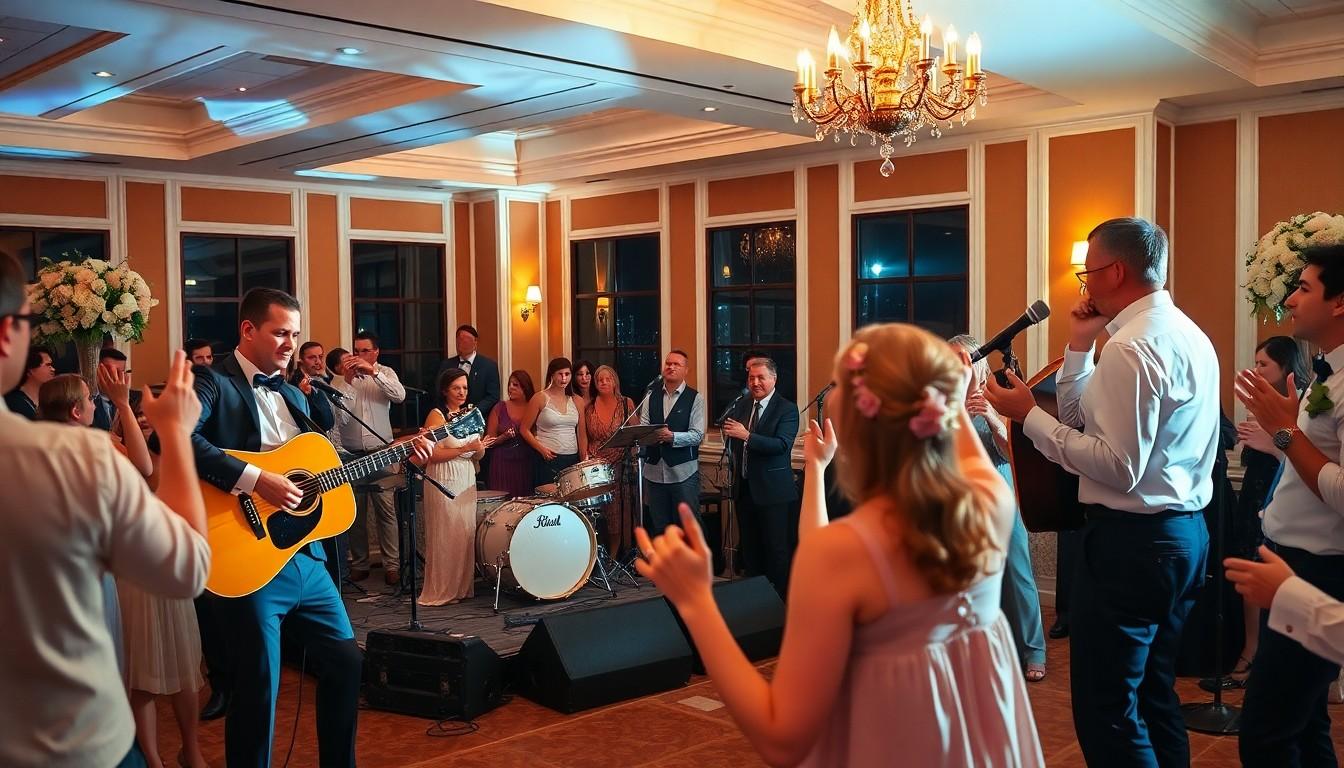Weddings are more than just vows and cake; they’re epic celebrations that deserve a dash of excitement. Picture this: guests mingling with laughter, dancing like no one’s watching, and maybe even a surprise flash mob that leaves everyone gasping. Choosing the right entertainment can turn a good wedding into a legendary one.
Types Of Wedding Entertainment
Live bands create an energetic atmosphere with captivating music that encourages dancing. DJs are another popular choice, providing a wide variety of songs and the ability to customize playlists. Performers such as solo musicians or acoustic duos can offer an intimate experience during cocktail hours or receptions.
Photo booths entertain guests by allowing them to capture fun memories with props and backdrops. Magicians add an element of surprise, engaging guests with tricks and illusions that spark conversation. Dancers enhance the celebration through choreographed performances, such as classic ballroom or cultural routines.
Interactive entertainment options include caricature artists, who provide guests with personalized illustrations, and game stations that invite friendly competition. Unique options like fire breathers or aerial performers can make a lasting impression while bringing excitement to the celebration.
Adding a live painter elevates a wedding by creating a beautiful artwork that captures the event as it unfolds. Comedians can entertain guests with humor, ensuring everyone enjoys light-hearted moments. Surprise acts, like flash mobs, transform ordinary moments into unforgettable experiences, further enhancing the festive atmosphere.
Consider incorporating these diverse entertainment options to cater to different guest preferences. By carefully selecting the types of wedding entertainment, a couple can create a joyful and memorable environment, ensuring every moment is filled with fun and excitement.
Live Music Options

Live music adds an enchanting touch to weddings. Various options ensure that couples can find the perfect fit for their celebration.
Bands
Bands create an energetic atmosphere that brings joy to all guests. They come in diverse genres, from classic rock to jazz, allowing customization based on the couple’s preferences. Wedding bands typically include vocalists, guitarists, bassists, and drummers, creating a full sound for dancing. Many bands also accept song requests, catering to the couple’s favorite tunes. Hiring a larger band often enhances the overall experience, as it can inspire lively interactions among guests, encouraging them to hit the dance floor. Popular choices include local cover bands and tribute bands, each offering a unique flavor to the event.
Solo Musicians
Solo musicians offer an intimate ambiance for wedding ceremonies and receptions. Guitarists, pianists, and string players frequently entertain guests with soft melodies during cocktail hours or while guests arrive. A solo musician’s performance can suit various themes, from classical to contemporary styles. They often personalize their sets, selecting specific songs that resonate with the couple. This tailored approach creates a memorable experience. Vibrant performances by solo artists infuse warmth into the celebration, allowing guests to connect through meaningful music while enjoying the event. Their flexibility in adapting to the venue size and ambiance makes them an excellent choice for any wedding setting.
DJs And Music Mixers
DJs and music mixers play a crucial role in setting the tone for a wedding reception. They create dynamic atmospheres that encourage guests to dance and enjoy themselves.
Benefits Of Hiring A DJ
Hiring a DJ offers versatility in music selection and adaptability to different crowd dynamics. DJs can seamlessly blend various genres, catering to diverse musical tastes among guests. They often possess extensive playlists, ensuring that every generation finds something appealing. Professional DJs also excel in reading the dance floor, adjusting the tempo as needed to keep energy levels high. Additionally, DJs come equipped with quality sound systems and lighting setups, enhancing the overall ambiance without the need for additional equipment rentals.
Comparing DJs And Live Bands
DJs offer a distinct advantage over live bands in terms of versatility. Rather than being limited to a specific setlist, DJs can provide a broader range of music, adjusting their playlists instantaneously based on audience reactions. Live bands typically require more advance planning regarding song selections, while DJs can easily accommodate last-minute requests. Budget considerations also play a role; hiring a DJ usually costs less than hiring a full band. Through these factors, couples can decide which option best aligns with their wedding vision and guest experience.
Unique Entertainment Ideas
Weddings benefit from creative entertainment that engages guests and enhances their experience. Unique entertainment options can create memorable moments for everyone involved.
Photo Booths
Photo booths provide a fun way for guests to capture candid moments. Available in various styles, these booths can be customized to match the wedding theme. Many couples opt for props and backdrops that add personality to the photos. Guests enjoy taking instant prints home as keepsakes. The interactive nature of photo booths encourages socializing and laughter, making them a popular choice at weddings. Additionally, digital versions can share images online, creating lasting memories beyond the event.
Caricature Artists
Caricature artists offer a personalized touch by sketching fun portraits of guests. Skilled artists quickly capture likenesses, ensuring that each drawing brings out unique features in an entertaining way. Couples appreciate how these artworks serve as both entertainment and keepsakes. Guests often gather around to watch the creative process unfold, which fosters interaction and laughter. Having caricature artists at weddings adds an engaging element that appeals to different age groups, making it an enjoyable experience for everyone.
Interactive Experiences
Interactive experiences enhance the energy of weddings, offering guests unique ways to engage and have fun. These activities encourage participation, fostering memorable connections.
Dance Floors
Dance floors serve as central hubs of celebration during weddings. Couples often prioritize creating an inviting atmosphere with fantastic music and lighting. Additionally, dance contests or fun group dances provide excellent opportunities for guests to join in and showcase their moves. Hired professionals can lead line dances, ensuring guests of all ages feel comfortable participating. Various themes, such as disco or 80s night, can amplify excitement, encouraging guests to embrace their inner dancer. Custom playlists from DJs or live bands keep energy levels high while catering to diverse musical tastes. Engaging with the dance floor enhances the wedding experience, creating unforgettable moments for everyone involved.
Game Stations
Game stations offer delightful entertainment options for guests of all ages. Popular choices include interactive games such as giant Jenga or cornhole, which encourage friendly competition. Additionally, photo scavenger hunts allow guests to explore the venue while capturing fun moments together. Couples can select games that align with their personalities and wedding themes, ensuring a personalized touch. Renting video game consoles with multiplayer games caters to tech-savvy guests, adding a modern flair. Incorporating these stations not only entertains but also fosters bonding and memory-making among attendees. Interactive games create a lively atmosphere, ensuring all guests feel included and engaged.
Choosing The Right Wedding Entertainment
Choosing the right wedding entertainment can transform an ordinary celebration into an unforgettable experience. By blending various entertainment options, couples can cater to diverse guest preferences and create an atmosphere filled with joy and excitement. Whether it’s the lively beats of a band, the engaging tricks of a magician, or the fun of a photo booth, each element plays a crucial role in enhancing the event.
Thoughtful entertainment choices not only keep guests engaged but also foster connections and create lasting memories. Ultimately, investing in the right entertainment ensures that the wedding day is not just a ceremony but a vibrant celebration that everyone will cherish for years to come.
